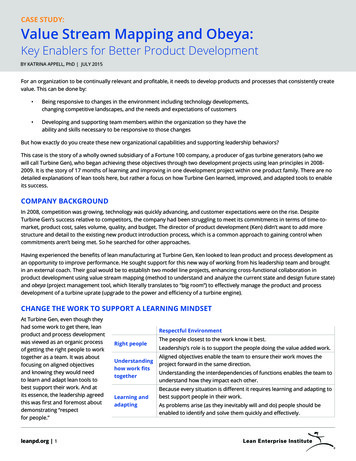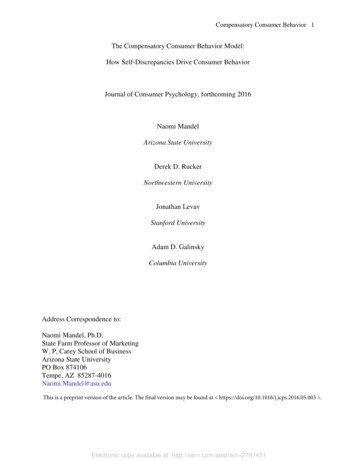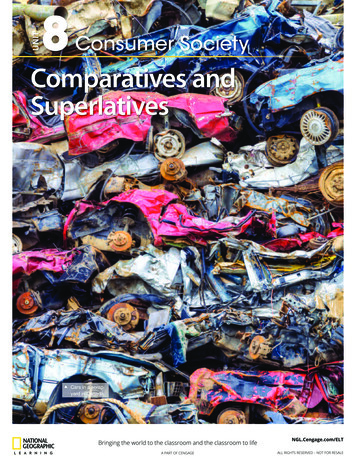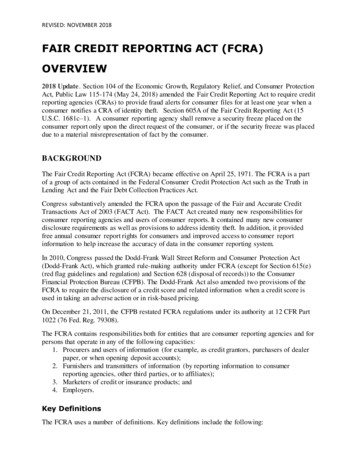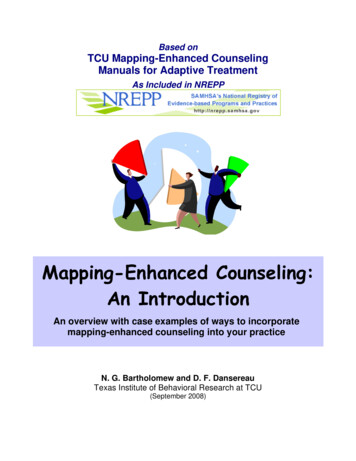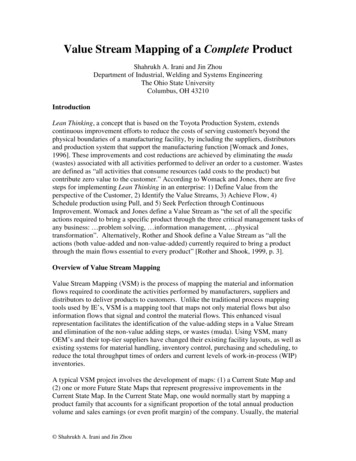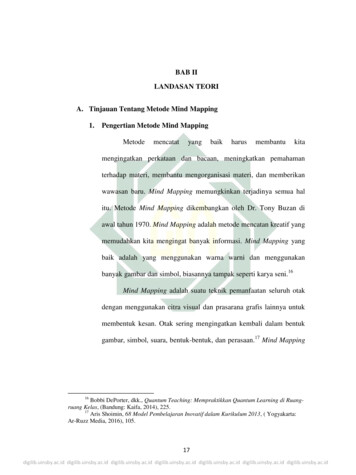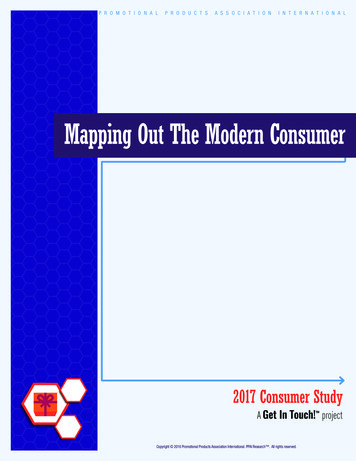
Transcription
P R O M O T I O N A LP R O D U C T SA S S O C I A T I O NI N T E R N A T I O N A LMapping Out The Modern Consumer2017 Consumer StudyA Get In Touch! projectCopyright 2016 Promotional Products Association International. PPAI Research . All rights reserved.
This research project was created in 2016 as part of the Get In Touch! campaign, a 1.5 million industrybranding initiative focused on raising awareness of the power of promotional products and elevating theposition of promotional consultants. The results of this research can and should be used in support ofthe Get In Touch! campaign and the industry effort to help spread the promotional products message.Results will also be made available to the industry by PPAI in easy-to-use customizable tools. For moreinformation about the Get In Touch! campaign, go to ppai.org/events/getintouchTHIS STUDY CONFIRMS U.S. consumers view promotional products as an important role in advertising. Consumers likepromotional products. Consumers keep promotional products. Consumers have spoken and they praise promotional productsas the leading advertising vehicle for brands.In 2015, promotional products shared almost seven percent of the advertising market in the U.S. alone, at 21 billion; however,Promotional Products wereRanked Highestby consumers across all generations as the MOST EFFECTIVEadvertising vehicle.These findings also reinforced the results of previous consumer studies by pointing out that promotional products innatelypossess the qualities consumers value and are built to succeed across the board in reach, recall, resonance and reactionperformance metrics.This is good news for brands, marketers and the promotional products industry.Details about this study’s participants and methodology can be found on pages 14 and 15.Mapping Out The Modern Consumer - 2017 PPAI Consumer Study2
Key Highlightsstated they comein contact withpromotional productsmost of the time orat all times per dayNearly5in 109 in 10remember the brand8in 10revealed theirimpression of a brandpositively changed83%are more likelyto do businesswith the brandPromotionalProductsRANKED #1Promotional products have the highest advertisingreach above any other form of advertisingproviding exposure each day. In fact, five out of10 consumers stated they come in contact withpromotional products most of the time or at alltimes per day.Nearly nine in 10 recipients are able toremember the branding and eight in 10 canrecall messaging from at least one promotionalproduct they received.Eight in 10 consumers revealed that theirimpression of a brand positively changed directlyas a result of receiving a promotional productfrom that brand.Roughly eight in 10 admit to looking up the brandafter receiving a promotional product, and 83%said they are more likely to do business withbrands they’ve received promotional productsfrom than brands they have not receivedpromotional products from.When asked to rate which advertising channelsprovide consumers with an incentive to takeaction, all generations regarded promotionalproducts as most effective.Mapping Out The Modern Consumer - 2017 PPAI Consumer Study3
IntroductionIn 1992, PPAI launched a pioneering series of consumer studies as the industry’sfirst assessment of the role of promotional products within consumer lifestyle andbehavior. While previous studies are commonly identified as airport intercepts,the 2017 Consumer Study is the first quantitative analysis of its kind. This newmethodology expands upon previous findings and is designed to better measurethe performance of promotional products among consumers to enhance ourunderstanding of their role as an advertising channel.Advertising has a tough job. While aiming to increase recall and improve resonance,advertising is also working to reach the majority of your target market at the righttime—the moments that influence consumers’ decisions—all to encourage action.Advertising channels, such as promotional products, are the mediums brands useto communicate branding and messaging to consumers to accomplish marketinggoals. But with so many options, how do brands choose their advertising channels?Advertising ChannelsAdvertising VehiclesBroadcastTV, Video, Radio, Cinema,Product PlacementOnlineDesktop Internet, Email,Social MediaMobileMessaging, ApplicationsPrintMagazines,Newspapers, Direct MailPROMOTIONALPRODUCTSBusiness Gifts, GiveawaysMapping Out The Modern Consumer - 2017 PPAI Consumer Study4
Fortunately, brands can use key metrics to compare advertising channelsand to guide campaign initiatives such as increasing awareness, solidifyinga memorable impression, encouraging a favorable perception and ultimatelyinciting action. In this study, key metrics are used to evaluate the valueof promotional products as an advertising channel as well as to comparepromotional products to other advertising channels—providing you with solidsales tools.Five key metrics were used to assess the value and weight of optionsused by survey respondents regarding each promotional productcomponent: Reach, Recall, Resonance, Reaction and ESONANCEREACTIONRELATIVITYDo promotional products elevate brand reach to deliver adequateexposure to recipients?Do promotional products produce high brand recall to generaterecipient awareness of the brand?Do promotional products enhance brand resonance to transfer afavorable attitude to recipients?Do promotional products stimulate reaction to influence change inrecipient buying behavior?Do promotional products gain relativity against other advertisingchannels to satisfy recipients?The Modern Consumer In The Driver’s SeatMapping Out The Modern Consumer - 2017 PPAI Consumer Study5
REACHThe power of promotional products cannot be disputed as they drive anundisputed level of brand exposure. They not only reach their target audience,but they also provide opportunities to reinforce branding and messaging withincreased exposure across the following performance metrics.FREQUENCY OF EXPOSUREThe majority of consumers are exposed to promotional productsmost of the time each day; however, the average Millennial said they are in contactwith a promotional product at all times.22%At all times28%Most of the time15%18%6-10 times2-5 times17%At least onceLENGTH OF EXPOSUREThe longer a promotional product is kept, themore impressions it makes on therecipient and anyone else who is exposed tothe recipient using the product. The majorityof consumers keep a promotional productbetween one and five years. Women maykeep a promotional product up to 10 years,whereas men may keep a promotionalproduct for 11 or more years.MenWomen Month3%7% Year14%15%1-5 Yrs38%43%6-10 Yrs22%22%11 Yrs23%13%81% keep promotional productsof consumersRANGE OF EXPOSUREfor more than one year*Categories are weighted and may not equal 100%Eight in 10 consumers choose to pass along a promotional product if theydon’t keep it for themselves, which ultimately furthers the brand’s reach.48%Gave item tosomeone elseright away41%Gave item tosomeone elseafter using it22%Donated itemright awayMapping Out The Modern Consumer - 2017 PPAI Consumer Study16%Donated itemafter using it6
RECALLBranding has everything to do with identity; who you are and what kind ofproducts and services you represent. Successful messaging then creates avoice for brands to connect with their target audiences and create a memorableconsumer experience. The call to action then directs recipients to take action,thus enabling brands to directly interact and engage with consumers, capturinga response rate and measuring quantifiable results. Promotional productseffectively deliver high recall between all three strategic advertising objectives.ATTENTION TO DETAIL*Categories are weighted and may not equal 100%When prompted with an unaided question, 83 percent said they recalled at leastone brand and 23 percent recalled at least one message from a promotionalproduct they received; however, if aided (or given options**), nine in 10 on averagecorrectly recalled branding, and eight in 10 recalled messaging characteristics,which indicates that consumers are not always aware they are being advertised towhen given promotional products.9 in 10 recall thebranding8 in 10 recall themessaging7 in 10 recall thecall to action**OPTIONS:So what type of ‘call’best resonatesCompany NameLogoSloganwith each generation?TaglineMillennials best recalled social media.Generation Xers best recalled directional Websitecalls to action, or statements with definitiveSocial Media Handleinstructions.ContactBaby Boomers best recalled pointsDirectionalof reference such as website domains orSocial Media Hashtagcontact information.Mapping Out The Modern Consumer - 2017 PPAI Consumer StudyBRANDINGMESSAGINGCALL TOACTION7
RECALLSTAYING POWER OF PROMOTIONAL PRODUCTSPromotional products allow brands to directly affect consumer lifestyles and maximizerecall by organically integrating into everyday routines at work, home or play. Wherepromotional products are kept also indicates emerging product trends for brands toconsider. Promotional products used in the kitchen and carried on one’s person are idealfor promoting to a general audience. However, if the target audience is gender-specific,one might consider particular product categories within that segment. For example, onemight consider promotional products used in vehicles for men (e.g. car charger) versus aproduct generally kept in the bathroom for women (e.g. nail file).Interestingly, one in two consumers said theywalk around with a promotional product suchas a wearable item or a pocket product.MenWomen50%On throom37%27%Bedroom23%27%Portable Carrier31%26%Storage27%16%Shared Space14%14%Outdoor Space13%*Categories are weighted and may not equal 100%Mapping Out The Modern Consumer - 2017 PPAI Consumer Study8
RESONANCEMaster marketer Seth Godin once remarked, “It is impossible to marketat people any more. The only choice is to market with them.” Advertisingthat creates resonance helps consumers to identify with the brand ona personal level and provides the foundation for an enduring brandrelationship. Promotional products are proven channel for brands togenerate a more favorable impression across all consumer audiences.EMOTIONAL CONNECTION TO PROMOTIONAL PRODUCTS*Categories are weighted and may not equal 8%Special%29%Impressed23%ConnectedEmotions are at the heart of the relationship between brands and consumers,subconsciously steering buying behavior. Promotional products resonate with consumers,driving consumers back to the brand. In fact, according to the 2015 Nielsen ConsumerNeuroscience Internal Study, advertising that produced the best emotional responsegenerated a 23-percent lift in sales volume.Mapping Out The Modern Consumer - 2017 PPAI Consumer Study9
RESONANCE10 REASONS RECIPIENTS OWN PROMOTIONAL PRODUCTSUnderstanding why an individual chooses to keep a promotional product receivedprovides key insight into which features are most valued by recipients. Unliketraditional advertising vehicles whose sole purpose is to communicate a message,promotional products not only bring value to brands by effectively connecting withrecipients but they also play a functional role within consumer lifestyles.Promotional products prominently display advertising, but they are found to be useful toa majority of consumers including a stunning 92 percent of the Silent Generation. AmongMillennials, 48 percent said they kept promotional products because the design fit theirstyle and/or personality, and both Generation X (42 percent) and Baby Boomers (48percent) said the product was enjoyable to have.*Categories are weighted and may not equal 100%FunctionalityUseful To Have85%EntertainmentEnjoyable To Have44%Fits Style/Personality43%Memorable Value28%ContentFavorable Message27%InformationEasy To Reference24%LoyaltySupports Brand22%LuxuryExtraneous To Have19%SymbolCause Alignment17%SocialConversation Starter10%DesignExperiencePROMOTIONAL PRODUCTS YIELD FAVORABLE IMPRESSIONS OF BRANDSAdvertising is designed to challenge consumer perceptions of a brand, and82 percent of consumers agreed that theirimpression of a brand positively changed as adirect result of receiving a promotional product.Mapping Out The Modern Consumer - 2017 PPAI Consumer Study10
REACTION“We don’t want people to buy a brand, we want people to buy into a brand,to make it part of their lives,” Stan Richards, founder of The Richards Group,once said. Advertising channels are the most important tool used by brandsto reach a targeted audience, ensure that it resonates positively so that,most importantly, it generates the desired reaction. Promotional productsare the optimal source to elicit a strong connection with recipients, sparkinterest, inspire action and effectively gain and retain consumers, ultimatelyenhancing brand loyalty.BRAND ALLURERoughly eight in 10 (79 percent) consumerssaid they have looked up a brandafter receiving a promotional product.Promotional products drove the mostinterest among Millennial recipients, 87percent of whom were curious enough totake further action.8 in 10BRAND FAVORABILITYWith the overwhelming selection of brands today’s marketplaceoffers, the average consumer might appear more elusive orerratic than ever in their decision-making. However, one mightargue that the right advertising vehicle has the power to shiftbrand favorability and ultimately influence a consumer’s buyingdecisions—and that’s exactly the case. In fact, 83 percent ofconsumers said they are more likely to do business with brandsfrom which they received promotional products over other brands.83 %BRAND LOYALTY35Results indicate thatconsumers who receivepromotional products aremore likely to increaseloyalty to the obablyNot WouldMapping Out The Modern Consumer - 2017 PPAI Consumer Study24%DefinitelyWould11
RELATIVITYAdvertising has experienced some major milestones. With the emergenceof the printing press in the 1440s, television in the 1940s and the latestadvancements in technology, brands have been presented with an endlessstream of opportunities to deliver their message. Today, brand strategy reliesdeeply in ad relativity insights when weighing where to invest advertisingdollars in order to make data-driven decisions. Luckily, promotional productsstand out as the consumer’s choice in brand communication.IDEAL ADVERTISING QUALITIES*Categories are weighted and may not equal 100%It is important to understand the wants and needs of a consumer in order for anadvertising vehicle to be successfully received. When asked what advertisingqualities (not limited to promotional products) were important to them, the majorityof consumers preferred visually appealing ads that clearly deliver a message.Promotional products are built to do just that with their physical and tangible features.65%60%Clearly DeliversVisually AppealingMessage47%41%Personally RelatableProvokes Emotion27%Provokes ActionMOST EFFECTIVE ADVERTISING CHANNELWhen asked to rate which advertising vehicles provide consumers with an incentive totake action, promotional products were regarded as most effective by all tMillennials GEN ping Out The Modern Consumer - 2017 PPAI Consumer Study12
RELATIVITYBEST RECEIVED ADVERTISING VEHICLEToday’s consumers are exposed to an expanding, fragmented array of touchpoints; however, there’s a growing sensitivity to the idea that consumers aretrained to be blind to advertising. The market for consumer awareness has becomeso competitive that attention can be regarded as a currency in the world ofadvertising. The rising cost of this element is reason enough for brands to considertheir return on investment, such as which ad vehicles have a higher probabilityof being received by consumers. Promotional products are better received & lessavoided by consumers than any other advertising vehicle.*Categories are weighted and may not equal 100%avoidonline videos68%avoid TVcommercials66%avoidweb ads57%avoiddirect mail50%avoid emailcommunication48%46%avoid radiocommercials46%avoidmagazine adsileavoid mob gmessagin38%discpromo ardtioproduc nalts20%promotional products are thebest received & least avoidedMapping Out The Modern Consumer - 2017 PPAI Consumer Study13
About This StudyMETHODOLOGYThe 2017 PPAI Consumer Study was conducted using an online panel fielded throughSurvey Sampling International (SSI) September 22-23, 2016, with more than 1,000consumers(n 1,042). Respondents were given a brief background beforebeginning the questionnaire. The average completion time ranged between 5-15 minutes.INCIDENCE RATEPercent of respondents qualified to participate in a survey based on sample conditions*89%Benchmarkinghad received promotionalproducts in the pastsix months, indicating acontinued upward trend201273%200471%199972%199262%*SAMPLE CONDITIONS:2016: Consumers who have received one or more promotional product(s) in the past six months2012 or prior: Consumers who have received one or more promotional product(s) in the past 12 monthsWHO TOOK THE SURVEY?18-34 yrs. oldGen XersMillennials35%35-50 yrs. old19%51-69 yrs. old3%Silent Generation43%Baby BoomersBy Generation70 yrs. or olderBy Gender50%WomenMen50%Mapping Out The Modern Consumer - 2017 PPAI Consumer Study14
ABOUT PPAIPromotional Products Association International (PPAI) has been the trusted authority in thepromotional products industry since 1903. With more than 14,000 member companiesworldwide, PPAI represents manufacturers, suppliers, decorators and distributors who market toadvertisers to help promote their businesses and/or brands. Advertising clients include Fortune500 companies, agencies nonprofits, schools, hospitals, charities and small businesses.For more information, visit PPAI.org and promotionalproductswork.orghas released industry sales data since1965; however, its bearing to the industry began gaining momentum in1985 following a shift in the Association’s initiative to broaden its reachand impact in the promotional products industry. Today, PPAI Researchprovides a wide range of resources to support its members and thepromotional products industry at large, as well as brands.The 2017 PPAI Consumer Study is available to all active members of the Promotional Products Association International (PPAI)with rights to use and reproduce, subject to proper citation. Content and graphics must not be altered or distributed for sale.No other use is permitted without the expressed written consent of PPAI.For citation guidelines or more information, contact PPAI’s Research Department: research@ppai.orgMapping Out The Modern Consumer - 2017 PPAI Consumer Study15
Emotions are at the heart of the relationship between brands and consumers, subconsciously steering buying behavior. Promotional products resonate with consumers, driving consumers back to the brand. In fact, according to the 2015 Nielsen Consumer Neuroscience Internal Study, advertising that produced the best emotional response



